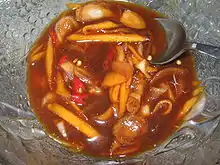Taba ng talangka
Taba ng talangka (Tagalog pronunciation: [taˈbaʔ naŋ talaŋ'kaʔ]), also known simply as aligue (Tagalog pronunciation: [ˈalɪgɛ]), is a Filipino fermented paste derived from the salted roe and aligue (reddish or orange crab "fat") of river swimming crabs or Asian shore crabs (talangka) sautéed in garlic and preserved in oil. It is traditionally sold in bottles and can be eaten over white rice, used as a condiment, or used as an ingredient in various seafood dishes. The name literally means "crab fat" (or even more literally "fat (tabâ) of crab (talangkâ)"), it can also be anglicized as "crab roe".[1][2][3][4] Most notably, it is used in flavoring a variant of sinangag (Filipino fried rice) known as aligue fried rice.[5][6]
 | |
| Alternative names | crab paste, crab roe, taba ning talangka, pula, tabang talangka, aligué, aligí, aligé |
|---|---|
| Course | Condiment, ingredient |
| Place of origin | Philippines |
| Similar dishes | bagoong |
See also
References
- Nora Narvaez-Soriano (1994). A Guide to Food Selection, Preparation and Preservation. Rex Bookstore, Inc. p. 111. ISBN 9789712301148.
- Edgie Polistico (2017). Philippine Food, Cooking, & Dining Dictionary. Anvil Publishing, Incorporated. ISBN 9786214200870.
- Cid Reyes & Gilda Cordero-Fernando (1991). Kusina: What's Cooking in the Philippines. Larawan Books. p. 10.
- Pineda, Maida; Lopez-Quimpo, Candice. "50 dishes that define the Philippines". CNN travel. CNN. Retrieved 8 December 2018.
- "Aligue Rice". Ang Sarap. Retrieved 10 April 2020.
- Alvarez, Lhas. "Seafood Aligue Fried Rice Recipe". Yummy.ph. Retrieved 10 April 2020.
This article is issued from Wikipedia. The text is licensed under Creative Commons - Attribution - Sharealike. Additional terms may apply for the media files.

